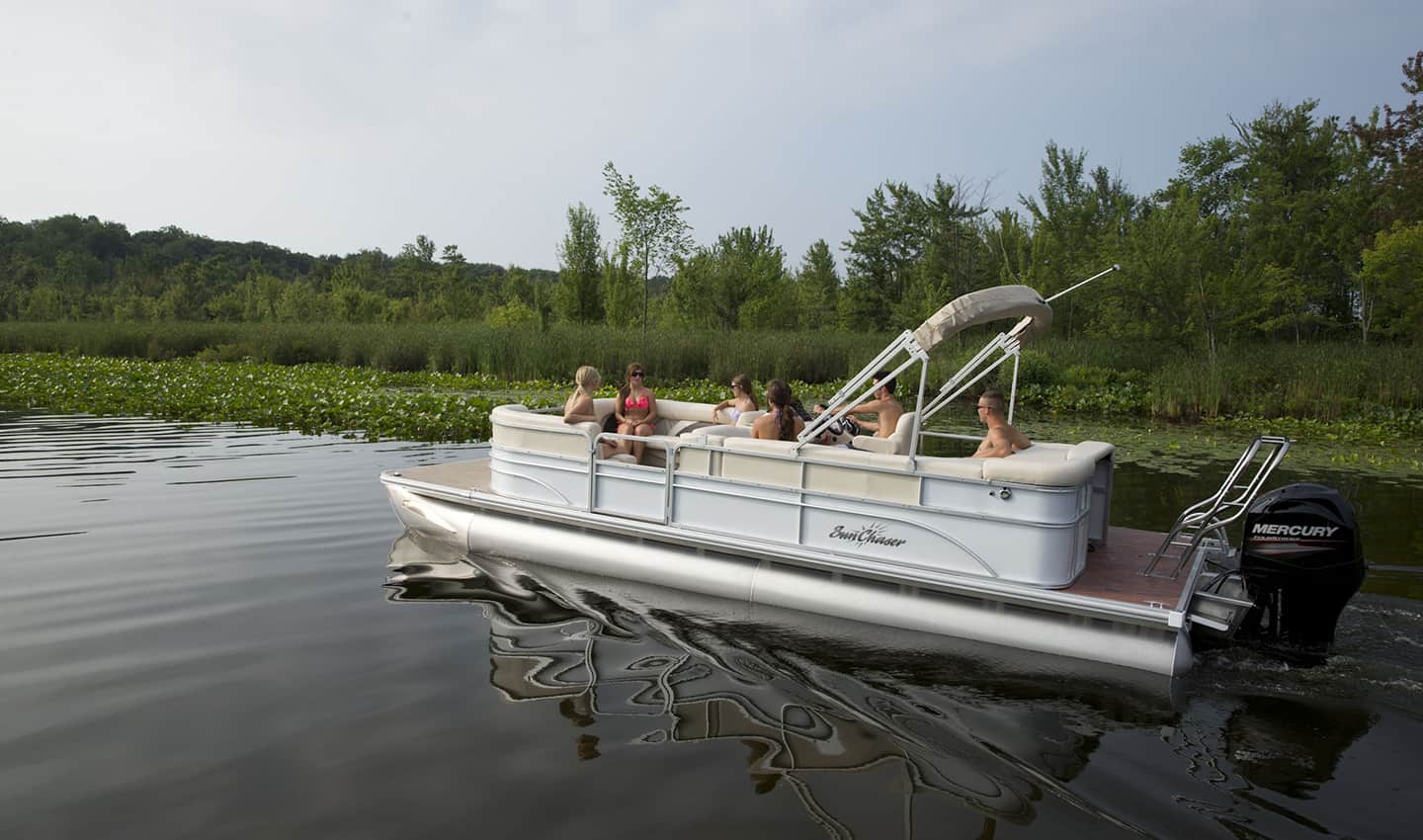How to Drive a Pontoon Boat in 5 Easy Steps

Whether you are a seasoned boater, first-time pontoon owner, or picking up a pontoon boat rental, the fundamentals of driving a pontoon are the same. In this article, we will break down how to drive a pontoon boat in 5 easy steps!
Pontoon boats offer a highly enjoyable boating experience. They are large enough for entertaining a group of people and ideal for various watersports.
Follow the below five steps to be fully prepared and confident in the captain’s chair.
Step 1: Pontoon Boat Safety
Before heading onto the lake, the first step is to make sure you have all your safety gear on board. You want to be prepared in case of an emergency. At a minimum, make sure you have the following:
- Properly sized life jackets (PFDs) for each passenger
- Functioning fire extinguisher
- Noise-making device (i.e. whistle, horn, etc.)
- Throwable flotation device
- Anchor
- Cell Phone
If you have a new pontoon boat, make sure to take some time to read the manual or even consider taking a safety course. You can read a complete list of recommended safety equipment here.
Step 2: Starting Your Boat
It’s time to turn on your boat and prepare for undocking.
- Turn on your battery switch; the location will depend on your boat.
- Next, we need to trim the motor using the trim button located on your throttle. This means moving the motor up or down in the water; it should be submerged but not touching the ground.
- Connect the kill switch cord to your body, somewhere it won’t interfere with your driving.
- Make sure your boat is in neutral and turn the key to start.
- Check your boat’s steering, battery level, engine temperature, and make sure you have enough fuel for your trip.
Step 3: Leaving Port
Now that your pontoon is running and you’ve checked all your gauges, you’re ready to take off from the dock.
- Have someone in your group untie the deck ropes and make sure they’re all inside the boat.
- Check your surroundings for any obstructions and that you’re untied from the dock.
- Pull your throttle lever back until it engages in reverse.
- Slowly back away from the dock by using short controlled bursts, so you have plenty of time to react to any obstacles that appear.
Step 4: Navigating the Water
Once you’re in the open water, handling and controlling the pontoon is easy:
- Use the steering wheel to control the direction of the pontoon; turn it until the bow (front of the boat) is pointed where you want to go.
- Push the throttle lever forward until you switch into drive and gradually push forward to increase your speed at a steady pace (adhering to any speed limits in place).
- Trim your motor all the way down now that you’re in deeper water.
- Keep one hand on the throttle and one hand on the steering wheel, so you’re always in full control of the pontoon.
- When you want to slow down, pull the lever back into neutral. There are no brakes in a boat, but you can switch the pontoon into reverse if you need to stop more abruptly.
- The size of the pontoon boat can make turning a challenge. Give yourself lots of room when making full turns, especially when you’re in tight areas.
There are a few things to keep in mind:
- Stay aware of your surroundings at all times
- Make sure the weight distribution is even between your passengers and gear on board when your driving
- Stay safe and cruise at 4500 RPM or slower
- To save on fuel, you can stay between 3000 RPM and 3500 RPM
Turning Your Pontoon
Turning a pontoon can be tricky because of its size, so give yourself lots of space and time when making full turns.
- Plan your turns ahead of time, looking ahead to prepare where you’d like to go.
- Drop down to a medium speed, and if possible, point the bow of the boat downwind, so the wind will help turn the pontoon smoothly.
- Warn your passengers ahead of time if you need to make a sharp turn so they can prepare themselves. Sharp turns can cause the boat to bank inwards and the stern to swing quicker than anticipated, easily catching passengers off guard.
- Avoid making sudden turns. The momentum can catch passengers off balance or send gear sliding across the deck, which could cause injury.
Note: If you hear howling from the propeller during a sharp turn and your speed suddenly drops, that’s called “blowing out” the propeller. This happens when the propeller takes in the air instead of water.
You can fix the problem by making sure your motor is trimmed all the way down during sharp turns or not turning as sharp.
Large Waves and Rough Water
Pontoon boats are fully capable of handling a bit of choppy water and aren’t likely to flip over. With that being said, you need to use common sense and understand how to handle the pontoon on rough water.
- Distribute the weight evenly on board; this includes all cargo and passengers.
- Make sure your passengers know the importance of maintaining balance on board.
- When possible, drive at a 30-45 degree angle into the waves instead of head-on. Cruising at an angle will help keep the bow of the boat up higher.
- If you need to drive directly into large waves, trim up right before hitting the wave. This will lift the bow of the boat and lessen the chances of bringing water on board.
Remember to keep an eye on the waves and be aware of the wind. This will keep you prepared for any unexpected situation that arises.
Step 5: Docking
When you’re ready to head in, you’ll need to dock your pontoon boat safely. Docking is easy to do but requires patience and focus. Keep practicing these steps, and you’ll be a pro in no time:
- Prepare your dock lines and fenders and trim your motor up enough that it won’t hit anything in the shallow water.
- Slowly approach the dock at a 45-degree angle, keeping aware of the wind, how deep the water is, and other boats that may be nearby.
- When you’re about 20-30 feet away, ease into neutral, bumping in and out of the drive as needed to slowly drift into the dock.
- Once the bow of the pontoon is close, put it in reverse and turn the wheel, so the motor moves towards the dock.
- Gently reverse until the stern (back of the boat) has been brought into place along the dock.
- Switch the pontoon into neutral and if possible, have a passenger grab hold of the dock to keep the boat in the correct position.
- Tie off your bow and stern lines to the cleat hitches on the dock, keeping the boat running in case it drifts and you need to react fast.
- Turn off the motor, battery and make any adjustments as needed.
Final Thoughts
Congratulations! You now know how to drive a pontoon boat successfully and safely.
It’s time to get out and take advantage of all the activities a pontoon boat has to offer. Whether you want to swim, fish, waterski, lounge in the sun, or simply cruise around with friends and family.
While you’re out on the water, always remember to stay safe, keep aware of your surroundings, and have fun!
This article may contain affiliate links which I earn a commision through when you purchase. As an Amazon Associate I earn from qualifying purchases.
Please read why I do this and my commitment to accurate and compelling content.


